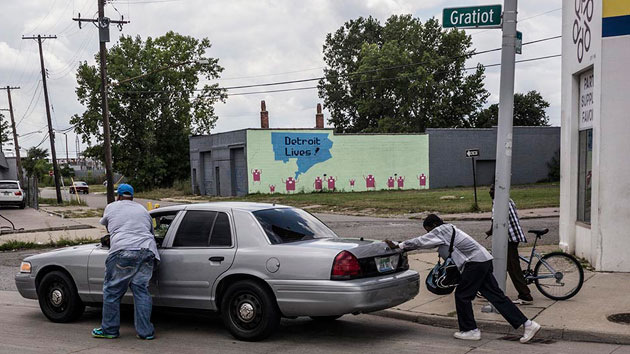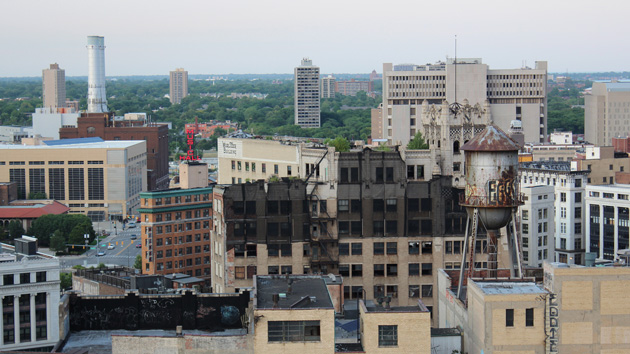
Texana Hollis, 101, reacts after discussing her eviction in Detroit. Hollis was evicted from her home in September 2011 because her son Warren failed to keep up with mortgage payments.John T. Greilick/AP
This story first appeared on the TomDispatch website.
Unlike so many industrial innovations, the revolving door was not developed in Detroit. It took its first spin in Philadelphia in 1888, the brainchild of Theophilus Van Kannel, the soon-to-be founder of the Van Kannel Revolving Door Company. Its purpose was twofold: to better insulate buildings from the cold and to allow greater numbers of people easier entry at any given time.
On March 31st at the Wayne Country Treasurer’s Office, that Victorian-era invention was accomplishing neither objective. Then again, no door in the history of architecture—rotating or otherwise—could have accommodated the latest perversity Detroit officials were inflicting on city residents: the potential eviction of tens of thousands, possibly as many as 100,000 people, all at precisely the same time.
Little wonder that it seemed as if everyone was getting stuck in the rotating doors of that Wayne County office building on the last day residents could pay their past-due property taxes or enter a payment plan to do so. Those who didn’t, the city warned, would lose their homes to tax foreclosure, the process by which a local government repossesses a house because of unpaid property taxes.
“Oh, my lord,” exclaimed one bundled-up woman when she first spotted the river of people, their documents in envelopes and folders of every sort, pouring out of cars, hunched over walkers, driving electric scooters, being pushed in wheelchairs, or simply attempting to jam their way on foot into the building. The afternoon was gray and unseasonably cold. The following day, in the middle of a snowless meadow in the Sierra Nevada Mountains, the governor of California would announce the state’s first-ever water restrictions as a result of an unprecedented, climate-change-influenced drought. Here in Michigan, city residents were facing another type of man-made disaster: possibly the largest single tax foreclosure in American history.
“It’s the last day to pay,” one woman heading toward the rotating glass chamber yelled to a pedestrian who had slowed to watch the commotion. Inside, a Wayne County Sheriff’s Department officer-turned-traffic-controller boomed instructions to a snaking line of people. “When you get to the eighth floor, you will get a number. Keep that number! Then go to the fifth floor.'”
The eighth floor, however, turned out to be little more than another human traffic jam, a holding space for thousands of anxious homeowners who faced hours of waiting before reaching the desk of some overworked city representative down on five. Yet, as a post office delivery worker gaping at the fiasco told me, this was less hectic than it had been a only few days earlier, when the treasurer’s office had rented out the Second Baptist Church across the street. There, people waited for the opportunity to enter the revolving doors to take the elevator to the eighth floor before heading for the fifth floor to…you get the gist.
In fact, the whole week had been a god-awful mess. A day earlier, rumors had it, a woman had passed out in the elevator between the eighth and fifth floors en route to “making arrangements,” the euphemism for getting on a payment plan that might save your home.
“What happens if you can’t pay?” a slender man asked me as we dodged a new wave of people surging through the glass cylinder.
“Then they sell your house at auction,” I replied.
“For real?” he asked, amazed.
He was waiting for his sister to make those “arrangements.” He didn’t have to worry about all this, he explained, because ever since he’d lost his job, which had provided him with housing, he’d been staying in motels. The Victory Inn over in Dearborn and the Viking across from the Motor City casino were both reasonable enough places, he assured me, but the Royal Inn on Eight Mile was the cheapest of all—$35 a night plus a $10 key deposit. That establishment’s single enigmatic Yelp review read: “This is definitely someplace you want to go where totally normal things happen.”
A Blueprint for Civic Hell
Detroit was once famous for creating the largest, most spectacular versions of whatever its residents set their minds to, be they assembly lines, record labels, or revolutionary workers’ associations. The city is often credited with inventing and mass-producing the twentieth century, while its workers simultaneously took the lead in revolting against the injustices of the era. Its factories put the world on wheels and labor laws on the books. Its workers and thinkers sparked and fanned a number of this country’s most influential resistance movements.
Detroit: every article about you should include a love letter, a thank-you note, a history lesson, for without you…
Few care to admit, however, that the city that was the arsenal of the twentieth century may also provide the blueprint for a more precarious era. Which brings us to those massive tax foreclosures of the present moment. Just over 60,000 homes, about half of them occupied, are slated for the auction block. As many as 100,000 of the city’s residents—about a seventh of the total number—are now on track for what many are calling an eviction “conveyor belt.”
Such an image easily springs to mind in this city whose auto factories were famous for their oh-so-efficient shop floors. These days, sadly enough, it’s all-too-easy to imagine a twenty-first-century version of a classic Detroit assembly line dedicated to processing its own residents, workers, and retirees—all the ones it claims to no longer need, all those too old, too young, too ill-trained, too inefficient for a post-bankruptcy city. These undesirables, it seems, are to be turned into so many economic refugees on a conveyor belt to nowhere. While everyone loves to hear about legendary industrial Detroit, no one wants to hear about its de-industrialized progeny, and especially not about foreclosures—not again.
Mike Shane, a Detroit resident and organizer with the anti-foreclosure group Moratorium Now!, knows this better than anyone. “We call the press, and they say, give us anything but foreclosures,” he tells me ruefully.
Connecting the Dots
On March 31st, some people did manage to make the necessary “arrangements” to save their homes. That included one woman with a Hillary Clinton-style hairdo who had lived on Winthrop Street since the 1960s, but like so many in the working-class sections of the city had fallen behind on her taxes. “They asked, ‘Why didn’t you pay your property taxes?'” she explained as she rested on one of the first-floor benches. “And I said, ‘Because I had a heart attack.'”
 Last year, she recalled, a neighbor’s home fell into tax foreclosure. A man who lived on the same block noticed the familiar address on the auction list. He bought it back for her, she tells me. “He said to the woman, ‘Pay me back when you can, if you can.'”
Last year, she recalled, a neighbor’s home fell into tax foreclosure. A man who lived on the same block noticed the familiar address on the auction list. He bought it back for her, she tells me. “He said to the woman, ‘Pay me back when you can, if you can.'”
Detroit is full of similar stories, filled with a stubborn sense of hope. But there are so many more addresses on the foreclosure list than angelic neighbors. By early afternoon that March day, the building still bursting at its seams with thousands of people, the county office conceded its inability to cope and extended the foreclosure deadline another six weeks.
“I don’t know if it’s because they’re so damn overwhelmed,” wondered Mary Crenshaw, a sunken-eyed woman who was relieved by the announcement, as it gave her time to wait for a lump-sum retirement payout from British Airways, her former employer. She had come to save her family home in Highland Park, a small city enclosed by Detroit whose once occupied homes sported oak floors and beveled glass windows. Now, more than half of them are empty, lawns overgrown, windows boarded up, the former homeowners having already ridden earlier foreclosure conveyor belts out of the neighborhood.
After all, this current tax foreclosure crisis comes right on the heels of the city’s last great displacement: the 2008 housing crash, which descended on Detroit like a tidal wave, sweeping nearly a quarter of a million people out of the city and leaving in its wake tens of thousands of vacant properties.
The fact that the city is now threatening to evict a seventh of its remaining inhabitants in a single year, all because of unpaid property taxes, seems like an absurd proposition until you begin to connect the dots: the mass water shutoffs, the shuttering of dozens of public schools, the neglect of fire hydrants in particular neighborhoods, and now this deluge of foreclosures.
Looking at the pattern that emerges, you can see that Detroit is not only a city in the midst of a “revival,” as enterprising investors and the national media often claim. It’s true that redevelopment is taking place in some neighborhoods, and city officials do claim that big changes are coming, often illustrating them with colorful documents that look like they were formatted by a team of graphic design wizards from the back of San Francisco’s Google Bus.
But that’s just one part of the Detroit story. For the city’s low-income, black, and elderly residents, Detroit isn’t a city on the rise, but one under siege.
An Emergency That Never Ends
On a blustery Saturday afternoon just two weeks before the day of the foreclosure deadline, an Emergency People’s Assembly Against Tax Foreclosures was held at Old Christ Church to address this siege. It was one of a set of “people’s assemblies” called to deal with the latest crisis in a city where, in recent years, crises have never been lacking. Before the tax foreclosure assemblies there had been the Emergency People’s Assemblies Against Bank Foreclosures, the Emergency Pack-The-Court Actions to Defend Homeowners from Eviction, the Emergency Town Halls to Defend City Pensions & Services, the Emergency Meetings Against the Emergency Financial Manager, and so on.
“Emergency” had, in other words, been the word of the moment for years and years. That invasive sense of never-ending urgency could similarly be seen in the literature of such groups—in the words always screamingly in capital letters, in the typographical equivalents of exclamation points. When I’d first heard about the most recent event, I was in a meeting with Mike Shane and I said to him, “Over the three years I’ve been visiting Detroit, I’ve never arrived at a time you weren’t holding an Emergency People’s Assembly the following Saturday.”
Shane laughed on cue. “Well, yes, that’s right,” he replied. “We’ve been at this since about 2007.”
The Old Christ Church that day was shiveringly cold. From the pew behind me came the sound of rustling coats as two children squirmed. Beside them sat their grandmother and grandfather, Lula and Daryl Burke, who had come to describe how their home had been sold at a tax foreclosure auction last year. With the help of the grassroots community group Detroit Eviction Defense, Lula explained, the Burkes had convinced the home’s buyer to sell it back to the family.
A little bit of gumption on her part helped, too. As she recalled explaining to the investor who had bought her home at auction, he could try to sell the house to someone else. But before he did that, she planned to strip every last thing out of it. “It won’t have a furnace, a toilet, doors, windows, all the way down to the light switch,” she warned him.
On the wall behind the altar three white-robed angels were suspended in mid-frolic, oblivious to the current condition of their once regal city. In front of them stood anti-foreclosure lawyer Jerry Goldberg. “Are we going to allow 62,000 more foreclosures this year?” he thundered, his face growing redder. I later learned that, years ago, Goldberg had sold peanuts down at the old Tigers stadium (now a bulldozed parking lot) and his unrelenting voice had apparently made him very good at it.
“No!” he responded emphatically to his own question. “Are we going to allow them to make our neighborhoods into a bunch of ponds?”
Perhaps I should have led with this information: in some of the city’s latest flashy Adobe InDesign-ed planning documents, certain of Detroit’s more down-and-out neighborhoods have been transformed into ponds. Or, to be more precise, they have been turned into “water retention basins” that planners believe will offer the Detroit of the future superior management of storm water runoff.
Minutes earlier, Alice Jennings, one of the most celebrated social justice lawyers in the city, had explained that, according to Detroit’s planning documents, those retention basins are slated to be built on top of now populated neighborhoods. In other words, ponds are also what we’re talking about when we talk about Detroit’s tax foreclosures.
“No!” Goldberg shouted yet again. “We need to stop these foreclosures with a moratorium, a halt! The idea that this can’t be done is hogwash! The Supreme Court held in 1934 that, during a period of emergency, the people’s need to survive supersedes any financial contract! The governor has a responsibility to declare a state of emergency!”
His sentences all ended in exclamation points, as his torrent of words resounded off the church’s high ceilings. In an upside-down universe, Goldberg would have made a skilled auctioneer rather than a man desperate to save all those homes and their inhabitants.
To be clear, Goldberg isn’t suggesting another of the emergency proclamations that Michigan’s governors have used to impose unelected emergency managers on school districts and municipalities from Detroit to Muskegon Heights. Rather, he’s calling for the governor to declare a state of emergency under Michigan law 10.31, which would allow him to “promulgate reasonable orders, rules, and regulations as he or she considers necessary to protect life and property”—including, of course, halting the tax foreclosures. In 1933, similar actions allowed Michigan’s legislature to pass the Mortgage Moratorium Act, later upheld by the Supreme Court, mandating a five-year halt on property foreclosures.
Winning that moratorium took, among other things, a well-organized national Communist Party, hundreds of worker councils, thousands of eviction blockades, and—I’d be willing to bet, although I don’t have the archival evidence—an incredible number of “emergency meetings.”
Woe to Those Who Plan Iniquities
By late afternoon, Goldberg was resting his vocal chords and about a dozen people from the audience were lining up to take the microphone, including Cheryl West, a tiny, gray-haired woman clutching a thick Bible to her stomach. When it was her turn to speak, she began: “I lost my home of 60 years.” There was no trace of bitterness in her voice, just a touch of awe and disbelief. “It’s been quite a journey. Quite a journey.”
“Let me give you a little background,” she continued. “My entire family is now deceased. My father was the first African American to teach music in Detroit, possibly in the entire state of Michigan. He worked for the school system. He lived in that very house. He lived there through the 1967 riots and we were right at the hub of where the riots started. My sister was a journalist, and during the riots she was one of the people getting the story out to the media, because she was working for UPI at the time. My sister was on the front page of the London Times, that’s how far her news traveled of the city burning down around us.”
Then, after a few more background comments on her life, she opened up her bible. “Since we’re in a church,” she said by way of explanation and began to read from the Book of Micah. She skipped its beginning.
“Woe to those who plan iniquity,
to those who plot evil on their beds!
At morning’s light they carry it out
because it is in their power to do it.
They covet fields and seize them,
and houses, and take them.
They defraud people of their homes,
they rob them of their inheritance…”
Undoubtedly, she assumed that everyone in the church was already familiar with such “iniquities” and the biblical lines that went with them. After all, in the previous few years, they had lived through the 2008 foreclosure crisis, the imposition of an emergency manager on their city, mass water shutoffs, and significant pension cuts for retired city workers, not to speak of all the evils that had come before.
Instead, she read the verses she liked best, the ones that, as she said, God led her to just about the time she lost her home.
“You strip off the rich robe
from those who pass by without a care,
like men returning from battle.
You drive the women of my people
from their pleasant homes.
You take away my blessing
from their children forever.”
She paused, then suddenly, in a surprisingly powerful voice, yelled the next line: “Get up! Go away!”
The church reverberated with her admonishment. And then, with a smile at her own audacity, she added, “The end.”
Shortly afterwards, we filed out of the church. And yet it was not the end. It never is.
There is now, for instance, that new deadline—May 12th—for residents to get on a payment plan to avoid losing their homes to tax foreclosure. That offers more time for people to navigate the revolving doors of the Wayne County Treasurer’s Office, head up to the eighth floor, then down to the fifth, all in an effort to fight their way off of the city’s conveyor belt to nowhere. And, of course, it gives residents more time to host emergency people’s assemblies aimed at throwing a monkey wrench —once and for all—into this assembly line of eviction and displacement.
Even if that happened, however, these gatherings, called for in all capital letters and exclamation points, undoubtedly wouldn’t end. They’ve become as much a fixture of this city as the women and men who organize them, the churches that host them, and the neighborhoods whose survival may depend on them. After all, the worst injustice would not be whatever provokes the next emergency people’s assembly, but the possibility of a future Detroit without such gatherings, one in which all these meetings and people are gone, all the stories have been suppressed. Imagine, then, the worst iniquity of all, the one so many are fighting against: a Detroit where once inhabited streets have been submerged in the silence of water retention ponds, where longtime residents have been scattered and displaced by the foreclosure conveyor belt and no one left in the city knows the history of what’s been drowned.
Laura Gottesdiener is a freelance journalist based in New York City. The author of A Dream Foreclosed: Black America and the Fight for a Place to Call Home, her writing has appeared in Mother Jones, Al Jazeera, Guernica, Playboy, RollingStone.com, and frequently at TomDispatch.
Follow TomDispatch on Twitter and join us on Facebook. Check out the newest Dispatch Book, Nick Turse’s Tomorrow’s Battlefield: U.S. Proxy Wars and Secret Ops in Africa, and Tom Engelhardt’s latest book, Shadow Government: Surveillance, Secret Wars, and a Global Security State in a Single-Superpower World.














